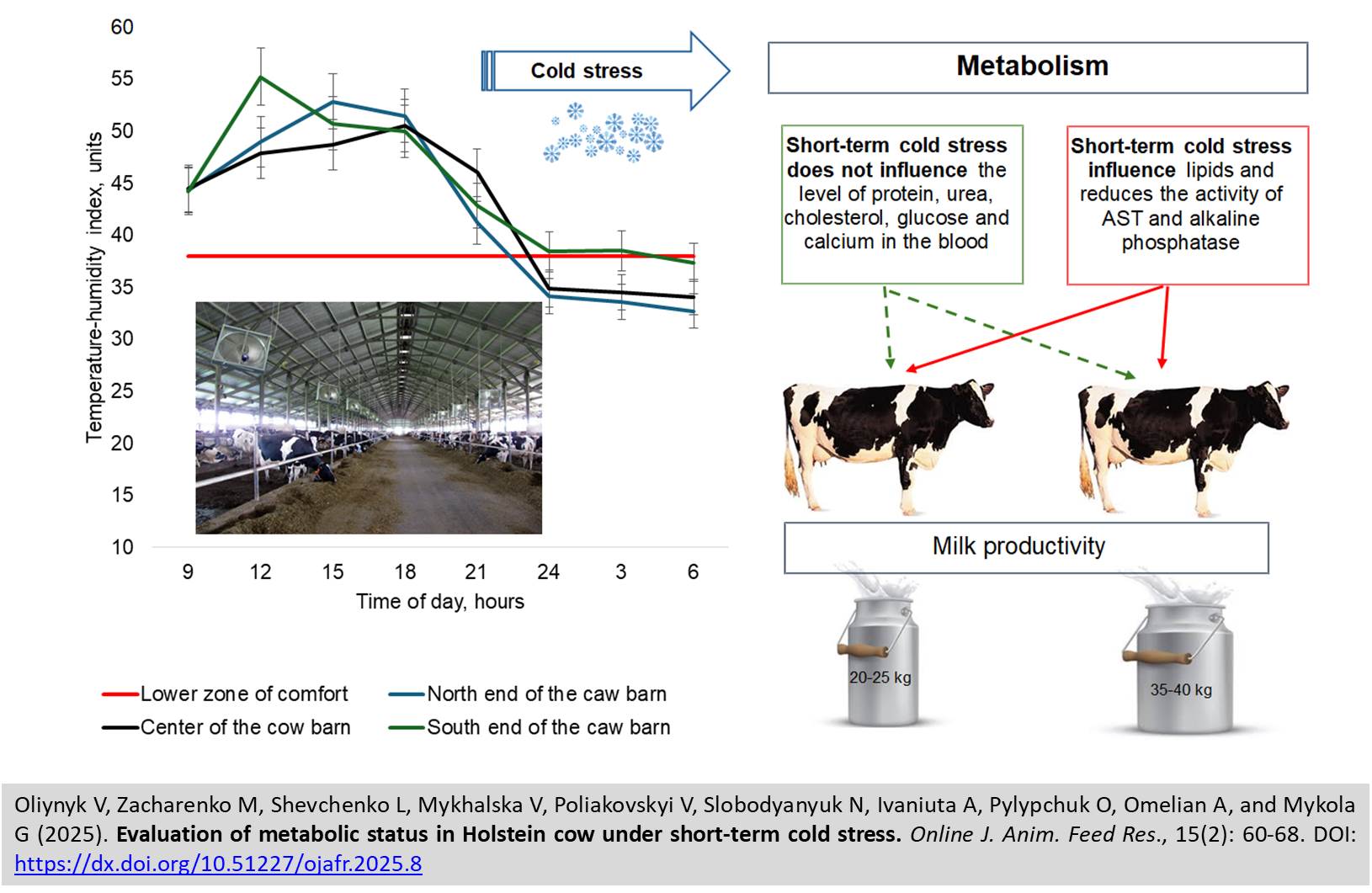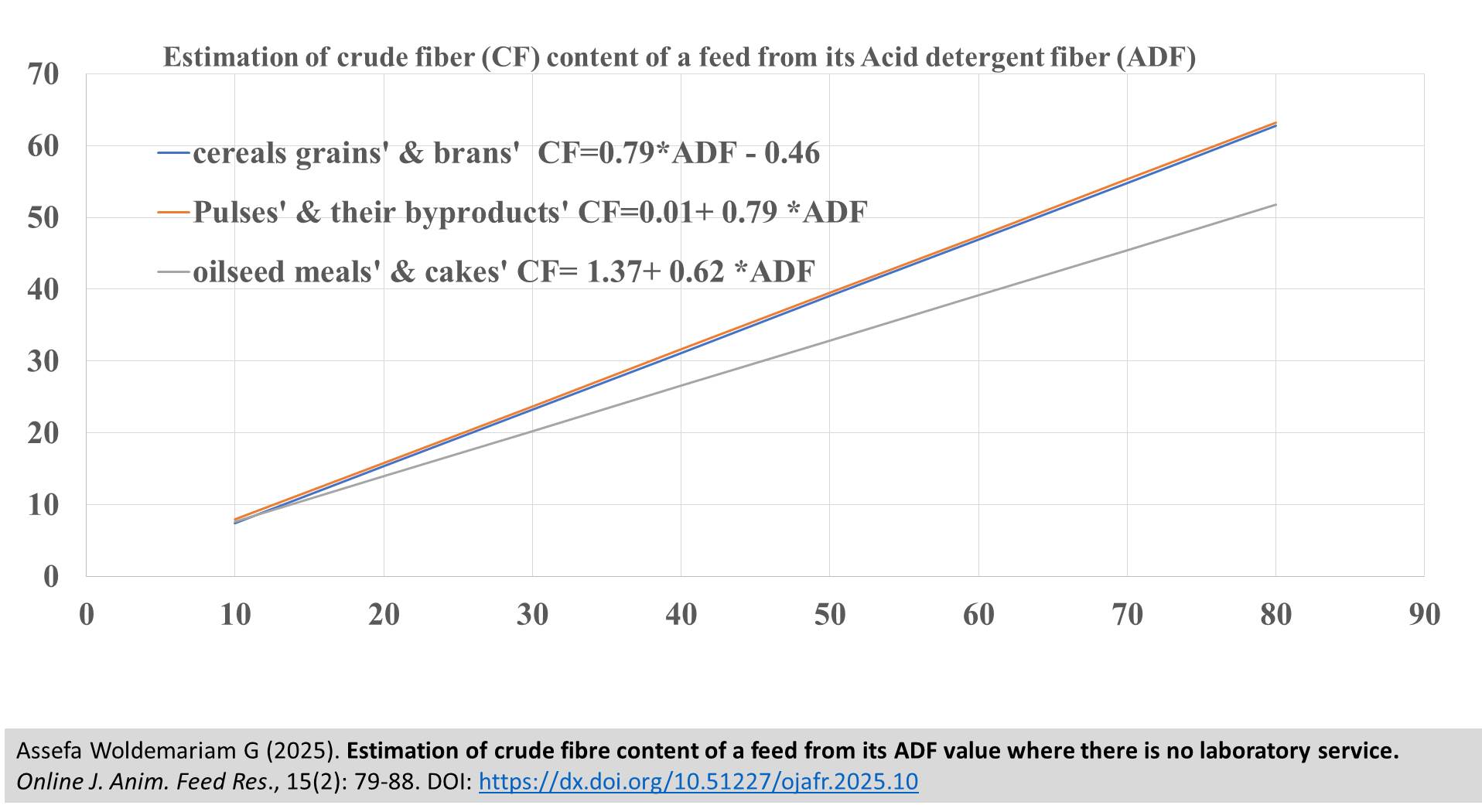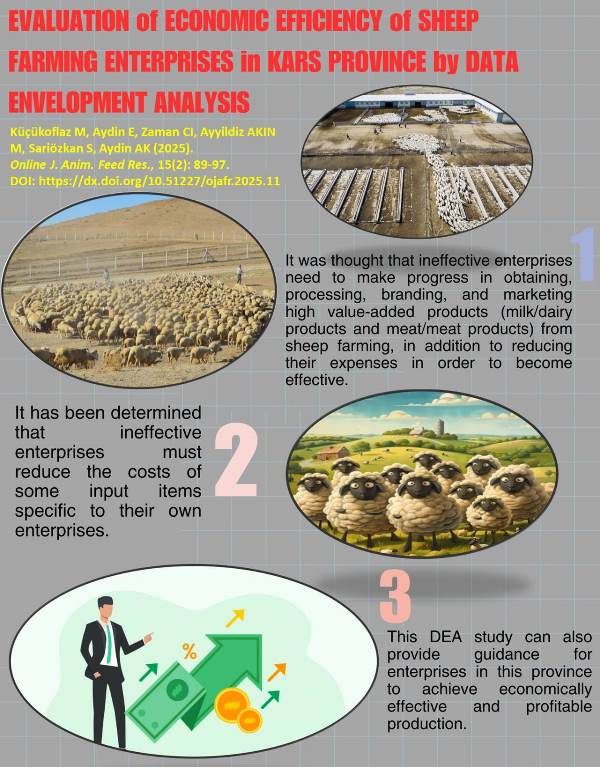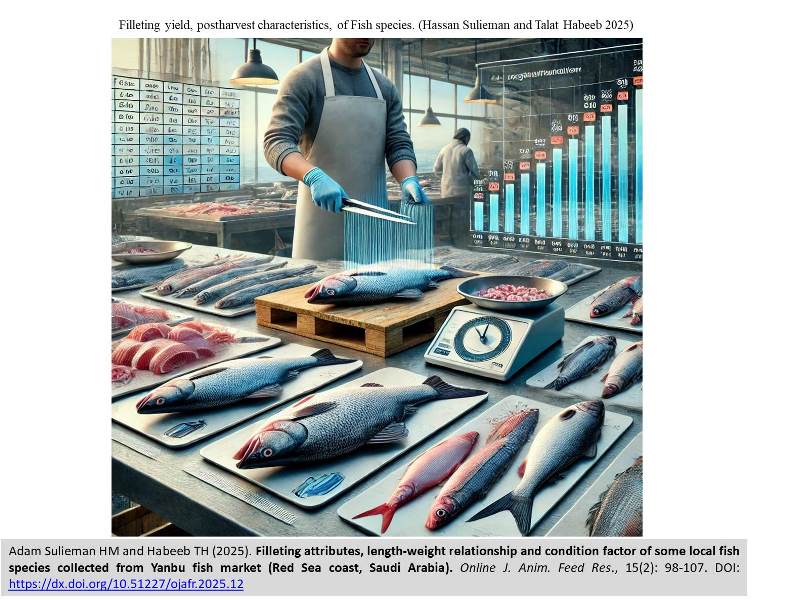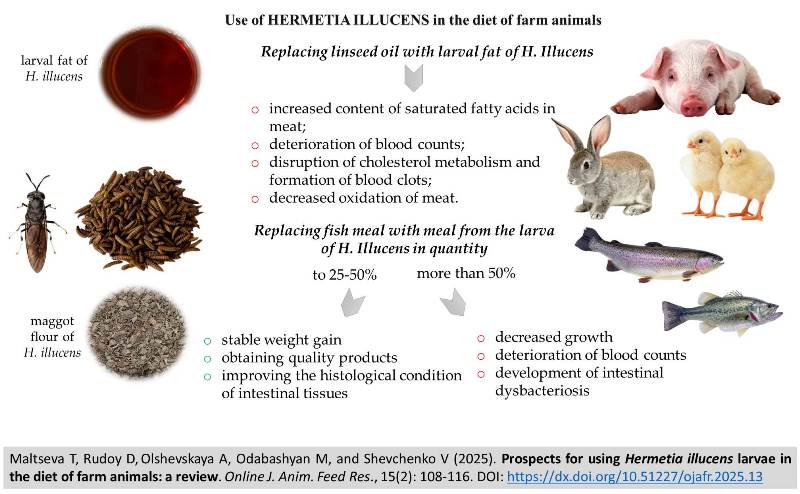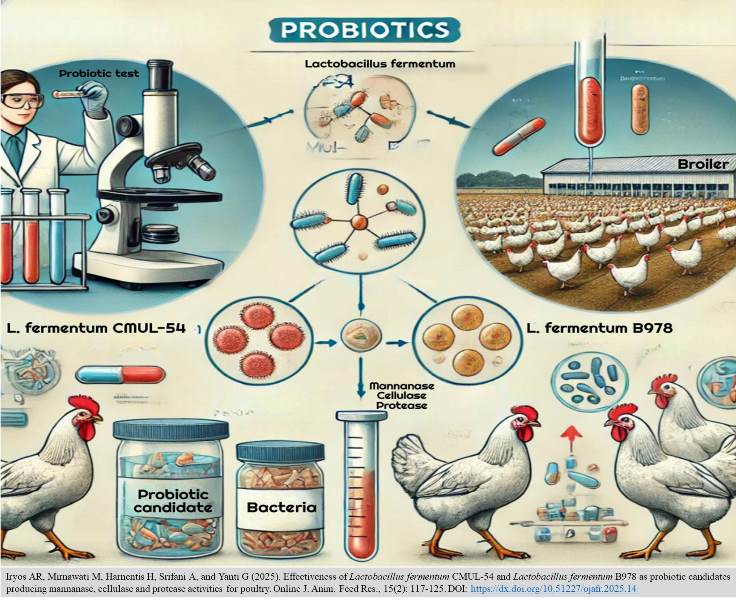Previous issue | Next issue | Archive
![]() Volume 15 (2); March, 2025 [Booklet]
Volume 15 (2); March, 2025 [Booklet]
Research Paper
Evaluation of metabolic status in Holstein cow under short-term cold stress
Oliynyk V, Zacharenko M, Shevchenko L, Mykhalska V, Poliakovskyi V, Slobodyanyuk N, Ivaniuta A, Pylypchuk О, Omelian A, and Gruntkovskyi M.
Online J. Anim. Feed Res., 15(2): 60-68, 2025; pii: S222877012500008-15
DOI: https://dx.doi.org/10.51227/ojafr.2025.8
Abstract
The research investigates the influence of short-term cold stress on the metabolic status of Holstein cows, when they are kept in large cowsheds in the Ukrainian climate. In the winter (cold season), the air temperature in such cowsheds depends on the ambient air temperature. The temperature-humidity index of the cowshed air is less than 38 at night, which is estimated as mild cold stress. Short-term cold stress has no effect on the level of total protein, urea, cholesterol, glucose, and calcium, but it increases the total lipids in the blood plasma of second-lactation cows with a daily milk yield of 20-25 kg by 32.3%, and in those with a daily milk yield of 35-40 kg, by 1.6-fold. For third-lactation cows with a daily milk yield of 20-25 kg total lipids increase by 1.5-fold compared with the data for first-lactation cows with a daily milk yield of 20-25 kg. Cold stress has no significant effect on the activity of alanine aminotransferase (ALT) and amylase, but it significantly reduced the activity of aspartate aminotransferase (AST) in the blood plasma of second- and third-lactation cows with a daily milk yield of 20-25 kg by 14.3% and 17.8%, respectively, compared with first-lactation cows with a daily milk yield of 35-40 kg. Under short-term cold stress, the activity of plasma alkaline phosphatase decreases by 36% in second-lactation cows with a milk yield of 35-40 kg, by 44% in third-lactation cows with a milk yield of 20-25 kg, and by 38% in cows with a milk yield of 35-40 kg compared to first-lactation cows with a milk yield of 20-25 kg. It can be concluded that short-term cold stress causes changes in the metabolic profile of high-yielding Holstein cows, which can provide valuable information about the health of the animals during acclimatization and help develop corrective measures to prevent diseases and reduce milk productivity in the coldest period of the year.
Keywords: Acclimatization, Cattle, Climate, Enzymes, Lactation.
[Full text-PDF] [Scopus] [Crossref Metadata] [Export from ePrints]
Research Paper
Methane emission of goats fed fifteen diets: on-farm observations
Sarkwa FO, Timpong-Jones EC, Adogla-Bessa T and Antwi V.
Online J. Anim. Feed Res., 15(2): 69-78, 2025; pii: S222877012500009-15
DOI: https://dx.doi.org/10.51227/ojafr.2025.9
Abstract
It is suggested that the measurement of methane production from enteric fermentation must be done under situations similar to that of typical farming methods. It is against this background that this study measured methane emission from goats on a farm to ascertain the real situation on most farms. The objective of this study was to measure performance and methane emission from goats fed Ghanaian ruminant diets comprising of basal diets supplemented with browse leaves and to determine the effects of temperature and humidity on methane emission. Ten West African dwarf goats (5 males and 5 females; average weight 14 kg ±1.01) were fed fifteen Ghanaian ruminant diets for four months. Each diet was randomly fed twice in 24 hours for 2 days in a month. Methane emission, temperature and humidity were measured using handheld gas methane detector. Completely randomized design was used. Dry matter intake (DMI) was lowest (P<0.05) when cassava (Manihot esculenta) peels were fed and highest (P<0.05) when plantain peels were supplemented with Moringa oleifera. Weight gain, DMI and methane emission from manure increased with time. The highest enteric methane emission was recorded (P<0.05) when untreated rice straw (749 ppm) was fed and the lowest was recorded (P<0.05) when Moringa oleifera leaves (313 ppm) were fed. High environmental temperature favored low methane emission and high humidity was associated with high methane emission. In conclusion, feeding browse leaves alone and browse supplementation with basal diets resulted in lower methane emission than feeding basal diets alone. Moderate weight gains were recorded. High environmental temperature was inversely related to methane emission and high environmental humidity was directly related to methane emission. It is recommended that, browse leaves be incorporated in the feed of ruminants, especially when environmental temperatures are low and humidity is high.
Keywords: Basal diets, Browse leaves, Dry matter intake, Humidity, Temperature, Weight gain.
[Full text-PDF] [Scopus] [Crossref Metadata] [Export from ePrints]
Research Paper
Estimation of crude fiber content of a feed from its ADF value where there is no laboratory service
Assefa Woldemariam G
Online J. Anim. Feed Res., 15(2): 79-88, 2025; pii: S222877012500010-15
DOI: https://dx.doi.org/10.51227/ojafr.2025.10
Abstract
Because of the cost and inaccessibility of laboratory facilities, animal feed formulation at the farm level, in many parts of Ethiopia, is based on feed database information. However, nowadays many laboratories are phasing out the Weende crude fiber (CF) method of analysis. The fiber content of feeds available in most feed databases (including the sub-Saharan Africa feeds composition database) are a result of detergent method analysis (NDF, ADF and lignin). However, CF is still used in poultry feed formulation and forage analysis for horses, in addition to the neutral detergent fiber (NDF) fraction for determining fiber in different countries. Since there is a statistically (P<0.01) difference between the CF and acid detergent fiber (ADF) value of a feed, ADF can’t be used directly in place of CF. Therefore, this work aims to formulate a regression equation that could roughly estimate the CF level of a feed from its NDF and ADF values. Considering the strong multicollinearity between NDF and ADF, this study developed separate models for ADF and NDF and compared them based on R² and Akaike Information Criterion (AIC), and the ADF-based model provided a better fit. The equations 0.79×ADF-0.46, 0.01+0.79×ADF, and 1.37+0.62×ADF have effectively predicted CF for cereal grains and beans, pulses and byproducts, and also oilseed meals and cakes, respectively. For grass forages, the equation 3.38+0.76×ADF, tested on 10 forages, showed potential but remains unreliable due to its R² value below 0.8. Finally, it is concluded that this approach provides a practical alternative for estimating CF where laboratory services or database information are unavailable.
Keywords: Crude Fiber, Estimation, Feed database information, Prediction, Regression.
[Full text-PDF] [Supplementary materials] [Scopus] [Crossref Metadata] [Export from ePrints]
Research Paper
Evaluation of economic efficiency of sheep farming enterprises in Kars province by data envelopment analysis
Küçükoflaz M, Aydin E, Zaman CI, Ayyildiz AKIN M, Sariözkan S, Aydin AK.
Online J. Anim. Feed Res., 15(2): 89-97, 2025; pii: S222877012500011-15
DOI: https://dx.doi.org/10.51227/ojafr.2025.11
Abstract
In this study, it was aimed to determine the economic activities of sheep farming enterprises in Kars province, Turkey by Data Envelopment Analysis (DEA). For this purpose, data obtained from face-to-face surveys conducted on 99 sheep farming enterprises in Kars Province were used. In the DEA applied to determine the economic efficiency of sheep enterprises, the Charnes Cooper Rhodes (CCR) was used according to the input-oriented scale. According to the study findings, the average age of the owners of the enterprises, all of whom were male, was 46 years, and their experience was average 9 years. It was determined that the majority of the farm owners (76.8%) were primary and secondary school graduates. It was determined that 67.7% of the enterprises were farming only Akkaraman, 3% were farming only Morkaraman, and 29.3% were farming both of the breeds. According to the DEA results used to determine the economic efficiency of enterprises, 41 enterprises (41.4%) were determined to be effective and 58 (58.6%) were determined to be inefficient. Consequently, it was concluded that inefficient enterprises need to reduce their input costs to become economically effective. In addition, it has been considered that it is very important for enterprises to make progress in the stages of obtaining, processing, branding and marketing high value-added products (milk/dairy products and meat/meat products, wool) from sheep farming to increase their income and profitability.
Keywords: Data envelopment, Economic efficiency, Kars, Sheep farming.
[Full text-PDF] [Scopus] [Crossref Metadata] [Export from ePrints]
Research Paper
Filleting attributes, length-weight relationship and condition factor of some local fish species collected from Yanbu fish market (Red Sea coast, Saudi Arabia)
Adam Sulieman HM and Habeeb TH.
Online J. Anim. Feed Res., 15(2): 98-107, 2025; pii: S222877012500012-15
DOI: https://dx.doi.org/10.51227/ojafr.2025.12
Abstract
Analyzing the filleting attributes of fish is essential for evaluating the commercial viability of fish products. This study assesses the filleting attributes, length-weight relationships, and condition factors of three commercially important fish species (Lethrinus nebulosus, Epinephelus tauvina, and Plectorhinchus gaterinus) from the Yanbu fish market in Saudi Arabian Red Sea coast. Fillet production results indicated a decreasing trend in edible portions among these species, with Lethrinus nebulosus yielding the most, followed by Plectorhinchus gaterinus and Epinephelus tauvina. Fish with smaller heads and medium-sized skeletons produced higher edible fillet yields. Linear regression analysis revealed no significant differences, establishing a linear correlation between net edible weight and fillet yield. The length-weight relationship analyses for Lethrinus nebulosus, Plectorhinchus gaterinus, and Epinephelus tauvina indicated positive allometric growth. Condition factor analysis showed that Lethrinus nebulosus had the lowest mean condition factor (1.05±0.05), while Epinephelus tauvina had the highest mean condition (1.67±0.15). A robust association between weight and fillet yield components was also observed. These findings enhance our understanding of the biological and economic characteristics of these species along the Yanbu coastline, supporting fisheries management and postharvest research in line with conservation and restoration efforts.
Keywords: Condition factor, Edible weight, Filleting yield, Fish products, Postharvest characteristics.
[Full text-PDF] [Scopus] [Crossref Metadata] [Export from ePrints]
Review
Prospects for using Hermetia illucens larvae in the diet of farm animals: a review
Maltseva T, Rudoy D, Olshevskaya A, Odabashyan M, and Shevchenko V.
Online J. Anim. Feed Res., 15(2): 108-116, 2025; pii: S222877012500013-15
DOI: https://dx.doi.org/10.51227/ojafr.2025.13
Abstract
Hermetia illucens larvae is a promising raw material as an alternative ecological raw material for obtaining feed ingredients. The aim of this review is to gain a comprehensive understanding of the current state of research in this topic by critically analyzing existing studies. Based on the review, recommended doses of defatted Hermetia illucens larval meal in the diet were identified. Replacing fish meal with Hermetia illucens larval meal in the amount of 25 and 50% ensures stable weight gain and high-quality fish products. When feeding largemouth bass and red hybrid tilapia, the recommended proportion of replacing fish meal with insect meal is no more than 30%. Substitution of vegetable protein with Hermetia illucens protein in the diet of sea bass in the amount of 40% improves the histological condition of intestinal tissue. Replacing linseed fat in the amount of 30 and 60 g/kg of feed with fat from Hermetia illucens larvae in feeding rabbits revealed a negative effect on meat quality: a high content of saturated fatty acids is observed. As a positive effect of Hermetia illucens fat, a decrease in meat oxidation can be noted. The use of full-fat Hermetia illucens meal in the diet of piglets should be limited to 2%. However, the protein of the Hermetia illucens larvae has great potential and can be partially replaced in combination with the protein of other insects. A number of studies presented in this review have proven the economic efficiency of using Hermetia illucens larval meal in feed production: the cost of Hermetia illucens larval meal is lower than the cost of fish meal by 0.35 USD/kg, which increases the profitability of using this type of raw material by 25%. The problems of the widespread use of Hermetia illucens larval meal in animal feeding have been identified, which consist in the low attractiveness of meat and fish products grown on feed using insects. In order to reduce the negative attitude of consumers to such food products, it is necessary to increase public awareness of the environmental friendliness and safety of using such components in animal feeding.
Keywords: Fat sources, Feed components, Hermetia illucens, Insect flour, Protein sources.
[Full text-PDF] [Scopus] [Crossref Metadata] [Export from ePrints]
Research Paper
Effectiveness of Lactobacillus fermentum CMUL-54 and Lactobacillus fermentum B978 as probiotic candidates producing mannanase, cellulase and protease activities for poultry
Iryos AR, Mirnawati M, Harnentis H, Srifani A, and Yanti G.
Online J. Anim. Feed Res., 15(2): 117-125, 2025; pii: S222877012500014-15
DOI: https://dx.doi.org/10.51227/ojafr.2025.14
Abstract
The present research investigated the potential of Lactobacillus fermentum strains CMUL-54 and B978 as a probiotic candidates with mannanase, cellulase, and protease activities. The materials used in this research included L. fermentum CMUL-54, L. fermentum B978, MRS Broth containing oxgall, and various equipment and chemicals for analyzing probiotic candidates, mannanase, cellulase, and protease activities. This study utilized quantitative analysis conducted using a paired two-sample t-test with ten replications. The results revealed that L. fermentum CMUL-54 could be significantly (P<0.01) used as a probiotic candidate, showing resistance to temperatures of 42°C (9.9x109±0.71 CFU/ml), gastric pH (72.35±0.80%), bile salt resistance (87.69±3.66%), and hydrophobicity test to the intestine (92.40±0.30%). Lactobacillus fermentum CMUL-54 also exhibited significant inhibitory zones against lactic acid bacteria (LAB) and pathogenic bacteria such as Escherichia coli (13.27±0.13mm), Salmonella enteritidis (13.91±0.13mm), Staphylococcus aureus (17.75±0.24mm), high activity mannanase (12.36±0.61U/ml), cellulase (12.42±0.24U/ml) and protease (11.30±0.08U/ml). It is concluded that L. fermentum CMUL-54 exhibited superior probiotic properties compared to L. fermentum B978, thus positioning it as a more promising candidate for improving broiler performance through enhanced digestion and overall health.
Keywords: Enzyme activity, Lactobacillus fermentum CMUL-54, L. fermentum B978, Probiotics
[Full text-PDF] [Scopus] [Crossref Metadata] [Export from ePrints]
Previous issue | Next issue | Archive
This work is licensed under a Creative Commons Attribution 4.0 International License (CC BY 4.0).![]()
| < Prev | Next > |
|---|

